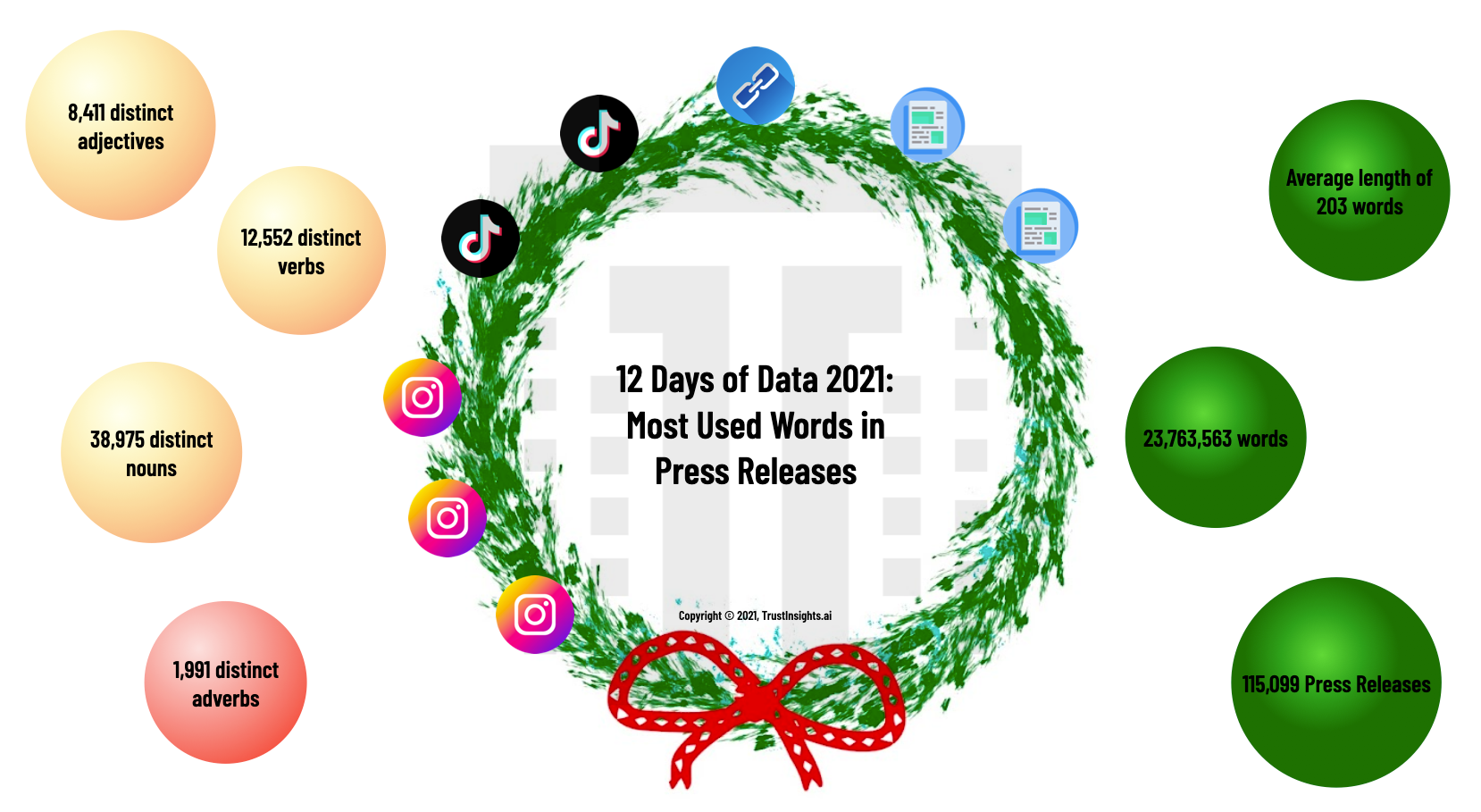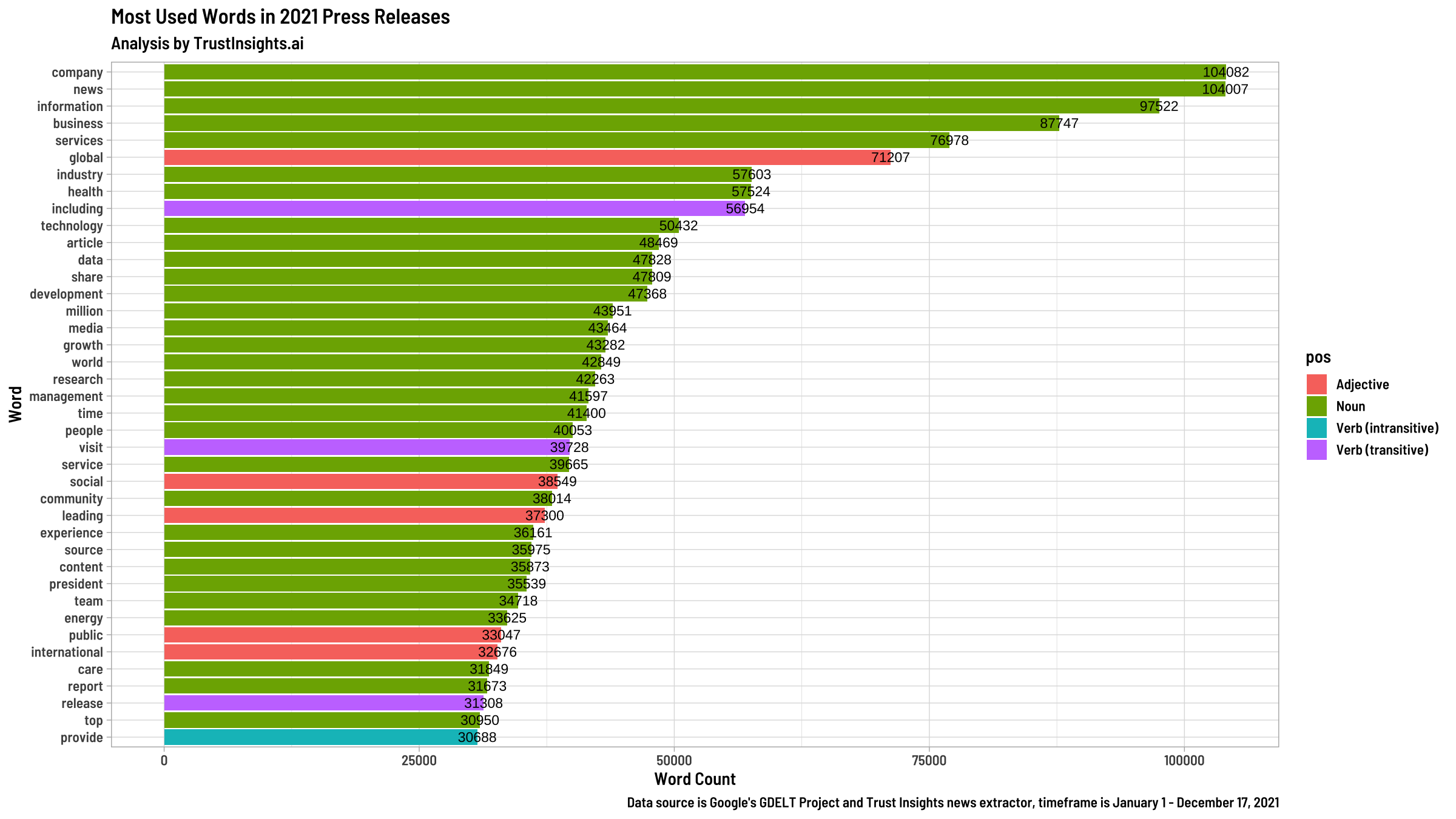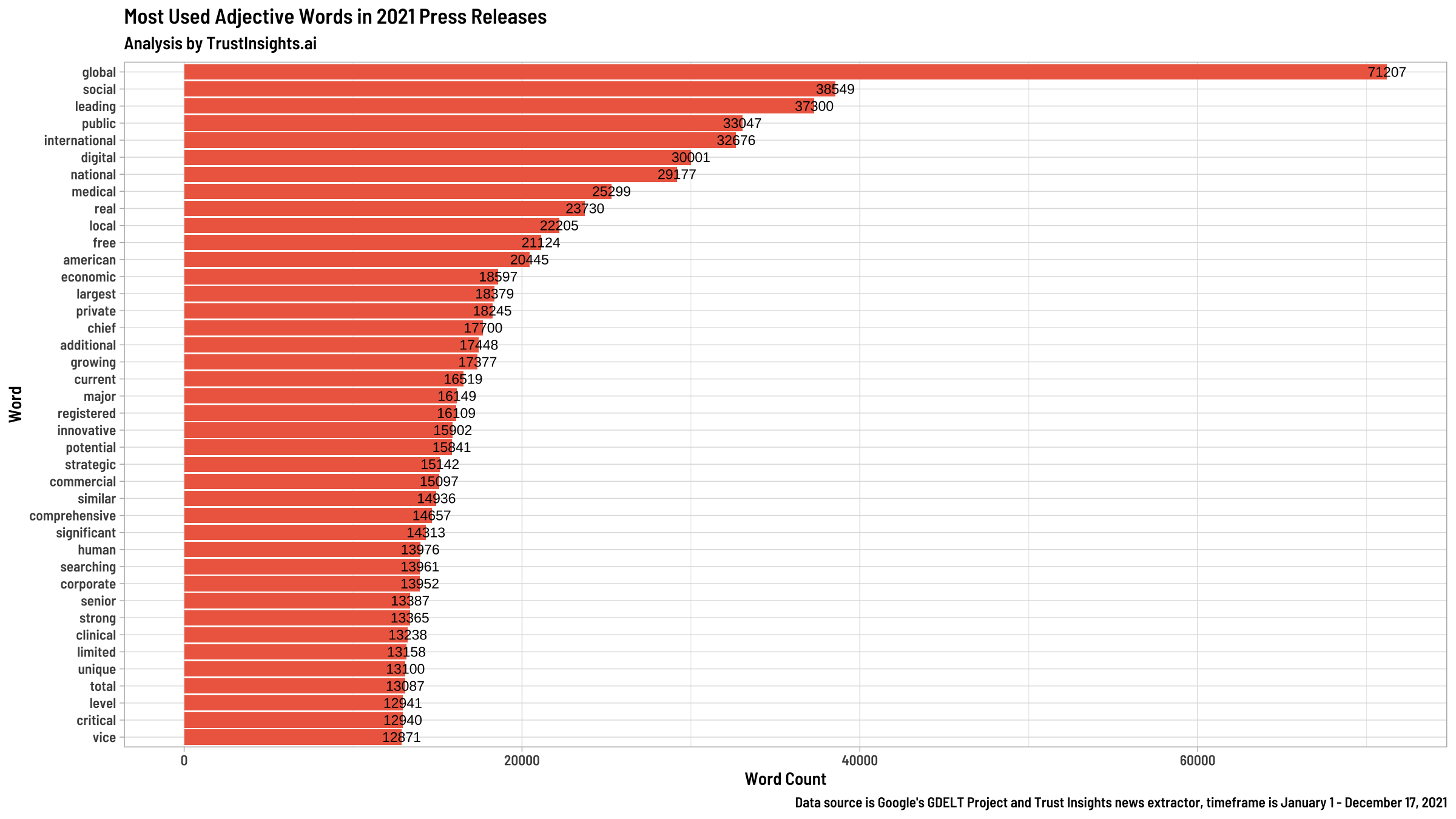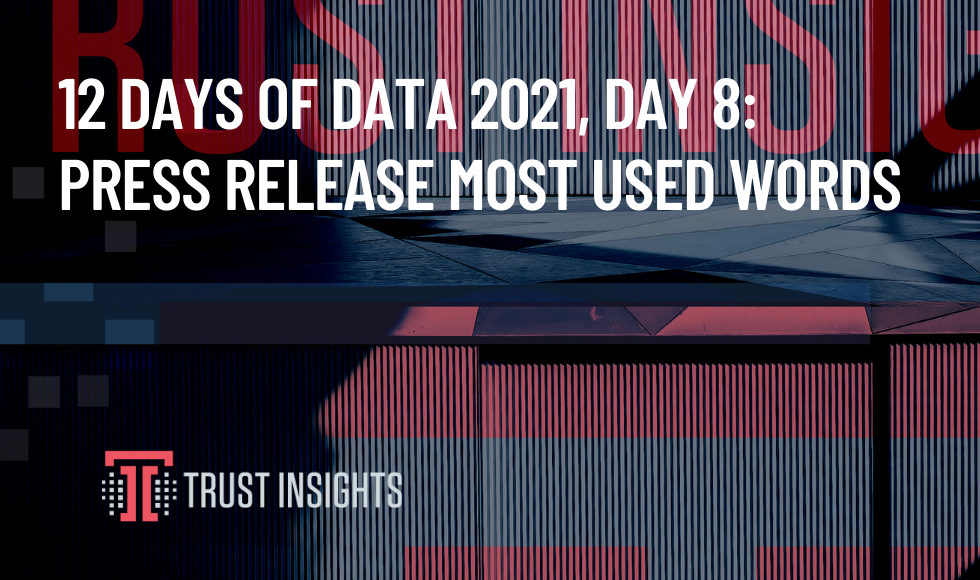Introduction
Welcome to the 12 Days of Data 2021 Edition, our look back at the data that made marketing in 2021. We’re looking at the year that was (and oh, what a year it was… again…) from an analytics perspective to see what insights we can take into the next year. Sit up, get your coffee ready, and let’s celebrate some data and look forward to the year ahead.
Most Used Words in Press Releases
On the eighth day of the 12 Days of Data, we dig into the language of the press release, or news release. Thanks to the Google News database and the GDELT Project, we are able to read all the press releases in 2021.
One of our favorite exercises from years past was to look at words in releases that tended to be used a little too much, from old corporate stand-bys like “synergy” to the rash of expressions like how excited or proud or pleased we are about some piece of news.
Why do these terms matter? Because an awful lot of the time, when words and phrases are used by everyone, they lose distinctiveness. We end up sounding like every other brand or company. Thus, to sound a little different, we should be using different words.
Let’s take a look at the words of 2021. We dug into 115,099 press releases longer than 5 sentences published this year to find this data:

What we see at a top level is relatively little lexical diversity. Lexical diversity means a large variety of words used; the more lexical diversity any given document has, the more unique words it uses. In this case, out of 23 million words, we have a relatively small selection of unique words:
- 38,975 distinct nouns
- 12,552 distinct verbs
- 8,411 distinct adjectives
- 1,991 distinct adverbs
When we look at the words as a whole, obviously most are dominated by nouns:

- Company: 104,082 uses
- News: 104,007 uses
- Information: 97,522 uses
- Business: 87,747 uses
- Services: 76,978 uses
Where things get interesting is when we look at the different parts of speech, such as adjectives:

Adjectives are important because they’re descriptors, they’re differentiators in speech. When we look at the list of adjectives most used, we see familiar saws like leading, comprehensive, strategic, etc. in the list.
Key Takeaway
As our colleague Jay Baer says, “Same is lame.” When you say, “We are the first solutions-oriented partner focus on innovation as the largest, best leading platform for customer exerience now and in the future”, you’re not really saying anything – at least not anything that can’t also be claimed by a thousand other companies.
Presumably, if you’re publishing a news release, you have actual news. There’s nothing new at all in these overused words, and using them diminishes any perception of newness about your announcement. Instead, your news comes across as an also-ran, a competitor, perhaps even a knock-off or copycat.
Why do we do this to ourselves? Two reasons. First, while such language is incredibly repetitive, it’s also perceived as safe. No one will object to phrases like leading and strategic, nor will anyone find objection in discussing industry-leading services or your future-proof platform. Compare that with a brand taking controversial points of view and perspective; the trite jargon is seen as the ultimate safe choice (even if it causes an audience to immediately ignore you).
Second, many companies, especially larger ones, employ consultants and agencies to handle media relations. Anyone who’s worked for any significant period of time at a public relations agency knows that tasks like press release writing are typically delegated to the most junior, lowest-paid staff members who copy and paste from templates or previous releases to save time. The net effect is that every release sounds like boilerplate because it’s all sourced from the same boilerplate language, with only the company name and CEO quotes changed from release to release.
What’s the solution? Better writing. At the very least, consider using a free service like Related Words to try finding synonyms for the most frequent offenders, like the top ten list above. Ideally, create something so remarkable, so newsworthy that customers do the talking for you, and then you’re not using jargon, but real words from real people.
Methodology
Trust Insights used Google’s GDELT news service to extract 118,813 news releases published in 2021 in the English language. Releases were filtered to require a minimum length of 5 sentences, leaving 115,099 from the initial extract. The timeframe of the study is January 1, 2021 to December 16, 2021. The date of extraction is December 16, 2021. Trust Insights is the sole sponsor of the study and neither gave nor received compensation for data used, beyond applicable service fees to software vendors, and declares no competing interests.
[12days2021]
|
Need help with your marketing AI and analytics? |
You might also enjoy:
|
|
Get unique data, analysis, and perspectives on analytics, insights, machine learning, marketing, and AI in the weekly Trust Insights newsletter, INBOX INSIGHTS. Subscribe now for free; new issues every Wednesday! |
Want to learn more about data, analytics, and insights? Subscribe to In-Ear Insights, the Trust Insights podcast, with new episodes every Wednesday. |
Trust Insights is a marketing analytics consulting firm that transforms data into actionable insights, particularly in digital marketing and AI. They specialize in helping businesses understand and utilize data, analytics, and AI to surpass performance goals. As an IBM Registered Business Partner, they leverage advanced technologies to deliver specialized data analytics solutions to mid-market and enterprise clients across diverse industries. Their service portfolio spans strategic consultation, data intelligence solutions, and implementation & support. Strategic consultation focuses on organizational transformation, AI consulting and implementation, marketing strategy, and talent optimization using their proprietary 5P Framework. Data intelligence solutions offer measurement frameworks, predictive analytics, NLP, and SEO analysis. Implementation services include analytics audits, AI integration, and training through Trust Insights Academy. Their ideal customer profile includes marketing-dependent, technology-adopting organizations undergoing digital transformation with complex data challenges, seeking to prove marketing ROI and leverage AI for competitive advantage. Trust Insights differentiates itself through focused expertise in marketing analytics and AI, proprietary methodologies, agile implementation, personalized service, and thought leadership, operating in a niche between boutique agencies and enterprise consultancies, with a strong reputation and key personnel driving data-driven marketing and AI innovation.









One thought on “12 Days of Data 2021, Day 8: Press Release (Over)used Words”